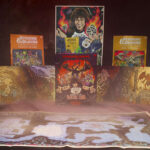When I first played Tales of the Shire back in September 2024, I left the experience disappointed yet hopeful. It had a lot of issues, yes, but it also had a lot of potential. There was a clear reverence for both Lord of the Rings and the life-sim genre on display, and considering the game had been delayed until the following year, it felt like both the developers and I were on the same page when it came to the game being undercooked. Imagine my surprise, then, when I booted up the launch version of Tales of the Shire and found the experience more or less unchanged.
Wētā Workshop’s Tales of the Shire feels incomplete. Gameplay is limited and monotonous, its story and characters are forgettable, performance is very rough, and while there’s some charm to the game’s clunky-looking world and the hobbits who inhabit it, more often than not, the visuals come across as low-quality and dated rather than whimsical. Despite playing it on two different consoles–Nintendo Switch and Steam Deck–both experiences suffered from numerous bugs and visual hiccups. While its mechanics are fine enough and there are some cute ideas nestled within, Tales of the Shire is regrettably unpolished and unengaging–and considering how populated the cozy game genre is, you’d be hard pressed to find a reason to play it in its current state.
Set in the village of Bywater (though it should be noted that the “village” part is hotly contested by its residents and serves as the crux of the game), Tales of the Shire sees you take on the role of a hobbit leaving the town of Bree to start a new life somewhere peaceful and pastoral. Though the game’s character creator is not particularly robust, it’s also not egregiously limited, and allowed me to create a charmingly plump hobbit with a mess of dark, curly hair, thick lashes, and two minimally hair-covered feet. Using the game’s suggested hobbit names, I named my maiden fair Jessamine–a clever play on my own name– and climbed aboard the carriage of a lanky, bearded wizard who was definitely not Gandalf–wink wink. From there, we rode in what would be the first of the game’s many awkward quiets to Bywater.
To its credit, Tales of the Shire does a fine job onboarding players. Once I arrived, I was informed that the quickest way to a hobbit’s heart, as you might have guessed, is through their stomach. As such, a lot of the game centers around gathering ingredients–be that through foraging, fishing, gardening, or bartering–whipping up meals, and inviting my neighbors over to share them with me. Though the initial series of quests you get to learn more about these aspects is a self-acknowledged wild goose chase turned into a series of grating fetch quests, the mechanics attached to each of these minigames, for lack of a better term, are simplistic but fun—even if the game doesn’t always thoroughly explain them. Fortunately, everything is fairly straightforward; foraging sees you harvest wild plants and fungi with the simple press of a button; fishing is neither brutal nor boring; and Tales of the Shire’s main event, cooking, is actually a pretty good time. It consists of you preparing ingredients in a way that aligns the overall meal on a grid with the axes smooth-chunky and crisp-tender. It’s a new take on a cooking minigame that makes it far less passive than it is in many life sims, and I really appreciate that fact considering cooking essentially serves as your love language throughout the game–it should feel like an act rather than a means.
Conceptually, I actually really adore this conceit. Though there are certainly some exceptions, a lot of cozy life sims games seem to boil down to you doing one of two things: establishing your residency via finding true love (Stardew Valley, Harvest Moon, Fields of Mistria), or encouraging a cast of colorful characters to set up residence in your newly-founded town (Animal Crossing, Disney Dreamlight Valley, Hello Kitty Island Adventure). In Tales of the Shire–and as the crotchety Old Noakes likes to remind you–you are a newcomer and decidedly not the town’s main priority or focus. You will not get the Gilmore Girls treatment here, and I admire that sort of authenticity. And, with no option to give gifts and no hobbits to woo, becoming a valued resident of Bywater feels genuine and like something you’re truly striving to do for the sole reason of establishing community.
In execution, however, Tales of the Shire fumbles hard for a number of reasons. First and foremost, not having certain end goals leads to the game lacking any prominent sense of progression. Sure, there is something to be said about how the human drive for progression and optimization is extremely un-hobbit-like, and therefore the exclusion of such systems is thematic, but I think that’s an overly generous reading and one that forgets that in order for a game to be engaging, there has to be some “game” to it. And while there are quests to complete, relationships to strengthen, and certain upgrades to attain, the game’s meager story, reliance on fetch quests, lack of deep characters with whom to have meaningful interaction with, and general indifference towards you as a character makes caring about doing anything extremely difficult. In short, I felt no extrinsic call to be a part of Bywater, and could not motivate myself to care intrinsically, either.
It doesn’t help that, despite these characters having dialogue that varies between delightfully dry and clever to at least serviceable, all of Bywater’s residents feel fairly lifeless and vacant. Part of this is due to their lack of depth, which makes them feel flat, undistinguishable, and impenetrable. But another part of this comes from the game’s choice to not include voice acting, prominent music, or even some dynamic sound effects, making interactions generally feel awkward.
Unfortunately, this lifelessness extends past just the characters and comes to define Bywater as a whole. Despite the changing seasons, there’s an overall lack of dynamism to the game. This is even reflected in your own dialogue choices, which are generally limited and feel almost unaware of the actions you’ve taken at times. While Bywater is decent in size, there isn’t a lot to do outside of the core gameplay loop, which grows old quickly, and much of it is filled with hobbits you can not interact with at all, but merely exist to make the world feel more populated. And though I understand the logic of this, especially since the game only has 15 actual characters in it, it just makes the entire village feel even more surface level. As time went on, I became thankful that decorating my hobbit hole was simple enough and encouraged as a time-passing activity–I never wanted to interact with much else.

It also seems likely that these NPCs’ existence contributes to another one of Tales of the Shire’s most pressing issues: its performance. Throughout my time reviewing Tales of the Shire, I played it across two different consoles: my Nintendo Switch and my Steam Deck. I started with my Nintendo Switch and, at first, I thought its performance issues were just on me for not having ponied up the funds to buy a Switch 2 yet. Items and characters clipped, my screen went black during interactions, and more than a few times, the game entirely froze and/or crashed. It also just looked shockingly horrible. I remember walking through Bywater and thinking I had played better looking games on GameCube 20 years ago–and to be clear, it has nothing to do with the game’s art direction and stylistic choices as much as how everything was rendered.
So, despite being hours into a game that I already was finding dull and frustrating to play, I decided to restart and give it a chance on my Steam Deck, which has always managed to run even more graphically demanding games just fine. Visually things were better, not great, but I still had to endure bugs, glitches, freezes, crashes, and the game being fairly lackluster as a whole.
As someone who loves Lord of the Rings, life-sims, and cozy games, Tales of the Shire is heartbreakingly disappointing–so much so that I find myself genuinely wondering what went wrong. With such a strong premise, a solid team working on it, and what seemed like a concentrated effort being made to let this game fully cook before it was shipped, I’m ultimately confused by the finished product and concerned for what happened during production. Although Tales of the Shire has some charming ideas, dull gameplay, heaps of bugs, and a general sense of emptiness ultimately drag this once-promising life sim down to the pits of Moria.









